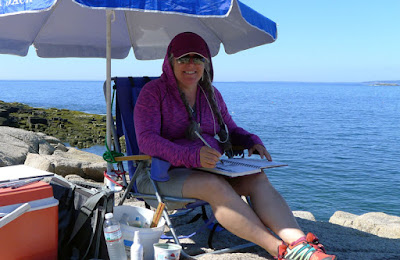I’ll wager that you won’t find a more interesting brace of workshops anywhere.
| The light is ever-changing on the open water. |
If you’ve been following my blog for a while, you know I moved to Maine for the painting. The light, the sea and the granite coast have drawn artists here for 200 years. I was just the latest sucker they snared.
In the early spring of 2016, I wandered into the North End Shipyard and asked if I could paint while they worked. The smell of varnish in the cold morning air brought back memories of equally frigid mornings on Lake Ontario.
 |
| Exploring off the American Eagle. |
That summer, Captain John Foss asked me to sail with him on the American Eagle. I painted some work I really liked. This October, I went out with them again, bringing watercolors instead of oils. I found that watercolor is perfect for capturing the changing scene from a boat under sail. And it’s less intimidating than oils. Several people tried painting with me.
 |
| This trip includes a gam, an open-water raft up of boats. That’s been known to include rowing troubadours. |
When we got back to land, Captain Foss and I designed the perfect trip for the artistically-inclined boat lover. Next June, he and his crew will sail us around the coast of Maine on their beautifully-appointed boat, providing berths and all our meals. I will teach you watercolors.
| From the galley. |
Can you even paint on a moving boat? Heck, yeah, and it’s fascinating. The water, sky and shoreline are constantly changing. We’ve scheduled this workshop for the longest days of the year so that we’ll have plenty of time to paint sunrises and sunsets while at anchor.
What if you prefer your ocean from the shore?
 |
| Schoodic is a wild and isolated place, but still accessible from Bangor International Airport. |
I offer a workshop at Acadia National Park’s Schoodic Institute every August. This is designed to help the painter find his or her own voice and style. It’s intensive, with morning and afternoon on-site painting sessions and lunch-time demos. Classes are kept small so every student gets the attention they deserve.
 |
| All mediums are welcome. |
Acadia is famous for its ocean breakers and big granite outcroppings. I’ve ferreted out some very exciting spots to paint, both in and out of the park. By the time your week is done, you’ll be at one with the wind, waves and pounding surf.
 |
| Breakers by Carol L. Douglas. |
Schoodic offers many other non-painting entertainments for the outdoors enthusiast. There’s biking, mountain climbing, fishing and hiking all in the immediate area. Seabirds, dolphins and grey seals are regularly sighted off the coast here.
Both trips are also all-inclusive, so you don’t have to worry about meals or accommodations. And both are designed so it’s easy to bring your non-painting partner.
 |
| The instruction is one-on-one and intensive. |
Why am I mentioning this now? Christmas is coming, but that’s not all. If you register before January 1 for either workshop, you get a discount. And I’m willing to wager that you won’t find a more interesting brace of workshops anywhere.
You can learn more about both workshops here.














